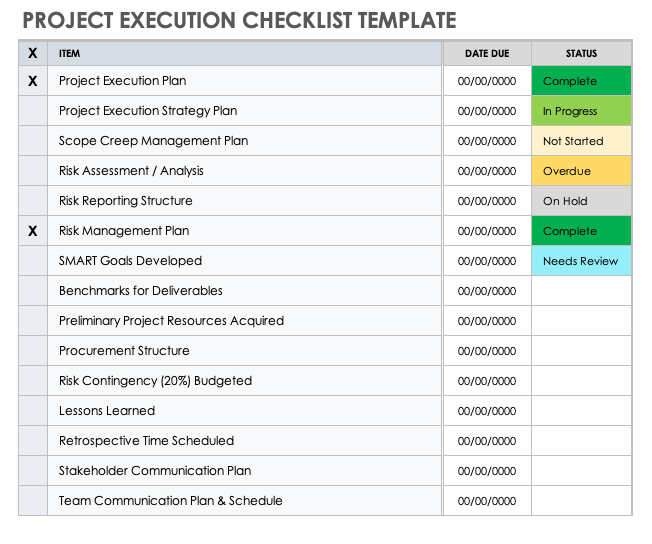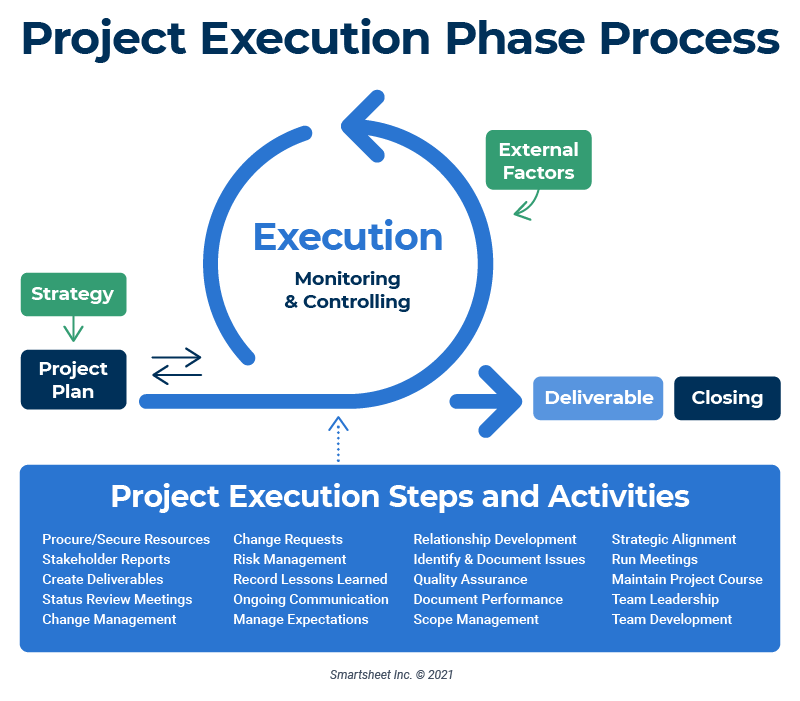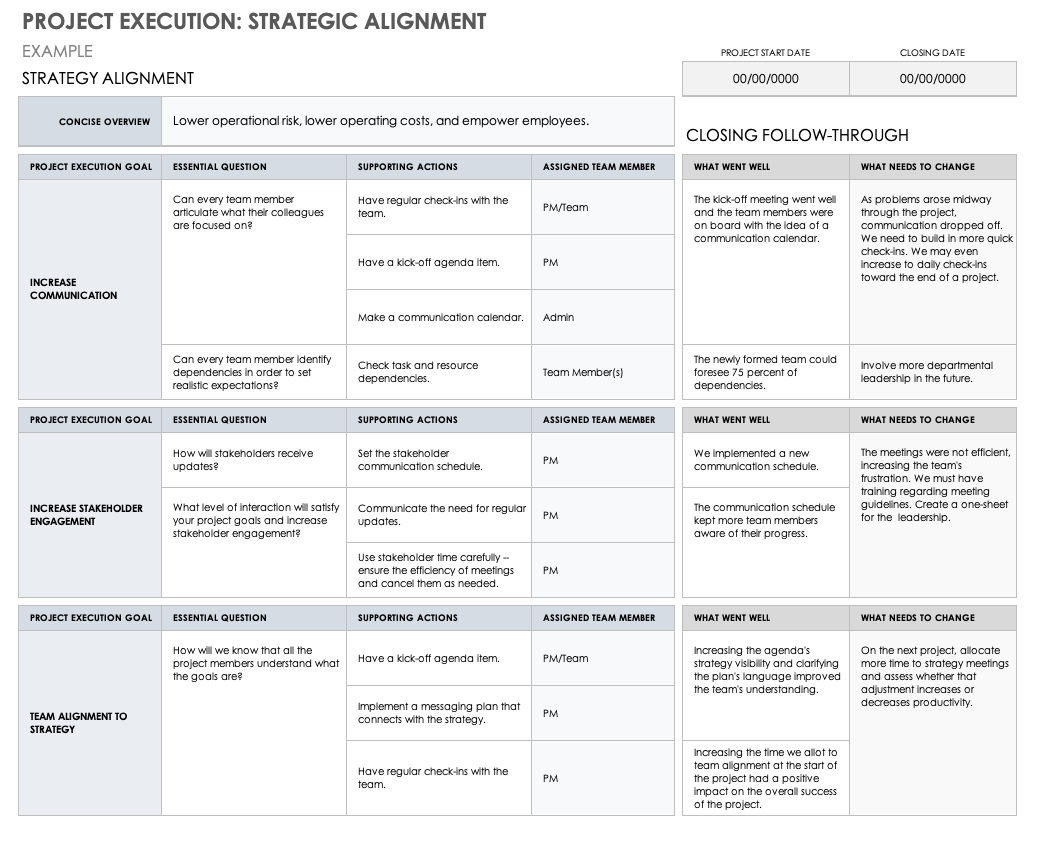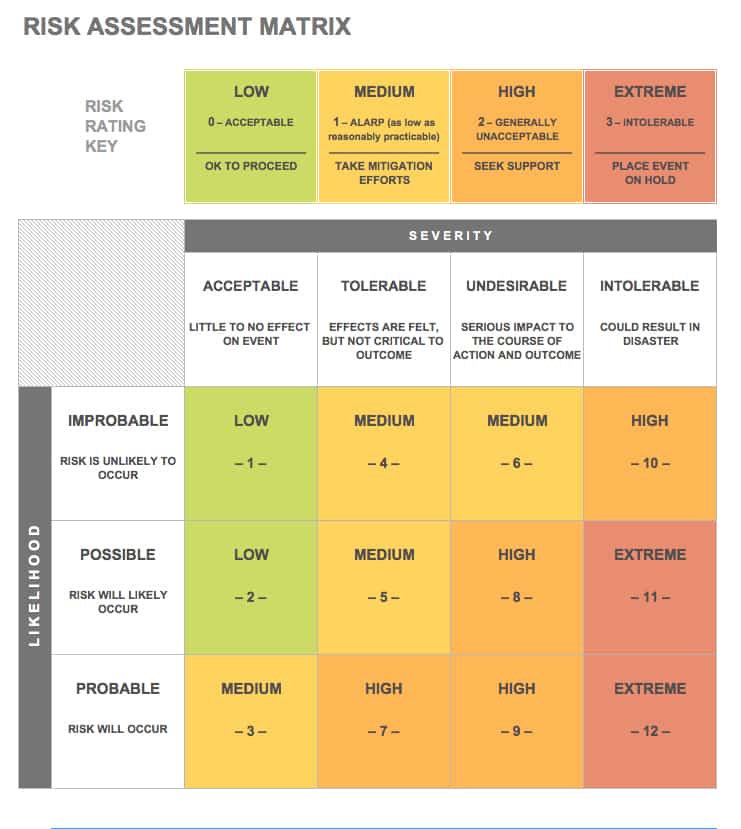What Is Project Execution?
The term project execution, also known as project implementation, refers to the actions a team takes during the third phase of the project lifecycle. It is the active stage of the project, in which you produce deliverables for clients and stakeholders.
During the project execution phase, a project moves from planning to completion. This is part of the traditional project lifecycle as outlined by Project Management Institute (PMI), the publisher of the PMBOK guide, which outlines a project from initiation to closing. The project execution stage is the longest, most involved, and most crucial phase of the project lifecycle (it can add up to 70 percent of the project). It’s also common to spend the majority of the project’s budget during this phase. Read our guide to the PMI PMBOK method to find more information on project management lifecycle and best practices.
Project execution is central to delivering value to stakeholders and meeting business goals. Successful execution involves catching missteps before they happen and monitoring the project throughout. A well-executed project will meet budget and schedule goals, and deliver the expected quality. This phase meets the immediate needs of stakeholders and provides long-term value to an organization’s reputation.
For further clarity on how to plan before launching your project execution, read our guide on demystifying the five phases of project management.
Project Management Guide
Your one-stop shop for everything project management

Ready to get more out of your project management efforts? Visit our comprehensive project management guide for tips, best practices, and free resources to manage your work more effectively.
What Happens During Project Execution?
During project execution, the project team delivers the agreed-upon products and services. Processes, frameworks, and methods support deliverable completion, as project execution calls for ongoing people management, flexibility, and communication.
A solid project plan provides the team with transparency on tasks, project needs, and strategy. It will also provide an understanding of the risk(s) involved and how the team should manage challenges as they arise. The planning stage is essential to keep the execution on track by providing a reference throughout the execution phase.
Activities during the project execution phase include the following:
- People management
- Ongoing communication
- Delivering project goals
- Reducing scope creep
- Monitoring quality
- Resource allocation
- Schedule management
What Is the Project Execution Process?
The term project execution process refers to the set of tasks needed to produce deliverables. Team members decide and assign execution tasks during the project planning phase. The execution process uses structures (techniques, methodology, and frameworks) to organize the manner of delivery.
The project manager will decide which structure best supports the project at hand. Commonly used process models include the following:
- Work Breakdown Structure (WBS): This is a visual tool that separates one or more items of a project’s data, services, or product, depending on project scope.
- Gantt Chart: Use a Gantt chart as a timeline to view project tasks, dependencies, resources, and work to be done, as well as communicate the progress of a project.
- Critical Path Method (CPM): This is an approach to divide a large project into work tasks, displayed in a flowchart that automatically calculates the estimated time of each task.
- Waterfall: This a traditional project management methodology is divided into seven consecutive stages: conception, initiation, requirements, design, implementation, testing, maintenance.
- Agile: This is an incremental and iterative approach, originally created for software development, that focuses on self-organizing teams and protocols from the Agile Manifesto. Agile is an overall mindset that uses some of the below frameworks to accomplish a flexible manner of productivity:
- Kanban: This approach applies cues (like a Kanban board) to grant visibility into all work.
- Scrum: A framework that uses sprints to accomplish project goals in shorter, iterative processes using a Scrum team structure (product owner, Scrum master, and development team).
- Lean: An approach that maximizes value and minimizes waste.
- Extreme Programming (XP): XP uses the principles of feedback, assuming simplicity, and embracing change to adjust quality and responsiveness to rapidly changing user needs.
You can learn more about project frameworks and methodologies (like Scrum, Waterfall, and CPM) by reading our guide to project management frameworks.
Project Execution Steps
The steps in project execution include a series of tasks to deliver a project on time, within scope, and under budget. The execution phase steps organize the project’s resources and coordinate the team’s efforts to meet the project goals as planned.
Project execution steps are not necessarily a linear progression between execution kickoff and closing, especially when you consider the external forces that may disrupt the project during implementation.
As Andy Jordan, Founder and President of the strategic management consulting company Roffensian Consulting, shares, “We miss the point if we only treat projects as a series of steps. Projects are approved to enable business benefits ... if the teams [who are] working on projects think about what has to happen to achieve that outcome, then they focus on how best to achieve that outcome. That may mean changing the steps, or it may mean introducing new steps. It may even mean abandoning the project and doing something different. But if it results in a better business outcome, then that’s what matters. Put simply, projects are about the outcome, not the steps to get to that point.”
You can break down the major actions required during project execution into four categories: produce deliverables, manage the team and stakeholders, monitor and control, and change management:
- Produce Deliverables: In order to build deliverables for clients and stakeholders, you’ll need to complete the following actions:
- Review customer requirements.
- Allocate and monitor the time required to complete each task.
- Control the quality in line with the user or client needs.
- Manage the Team and Stakeholders: It takes time to build trust and develop leadership skills within a team. Similarly, stakeholders need continuous engagement, and managing people in the project involves the following:
- Cultivate the team. Dedicate time and necessary resources to build a cohesive team.
- Communicate regularly with both the team and stakeholders on project needs and reporting status.
- Procurement of resources and supplies (as needed).
- Monitor and Control: Monitor and control is considered its own phase within a five-phase project lifecycle diagram, occurring directly after the execution stage (phase three). However, it is often combined with the execution phase because they technically occur simultaneously to keep the project on track. When you see a four-phased project lifecycle diagram, the team has combined execution (phase three) and monitoring and controlling (phase four) into one phase, typically referring to it as the “implementation” or “delivery” phase before the final closing phase. Regardless of which lifecycle diagram you use, monitoring and controlling requires several steps to ensure the team is meeting customer requirements and operations deliver a quality product. Steps include the following:
- Manage your time.
- Manage the budget.
- Verify project scope.
- Change Management: Project managers use tools and processes to help manage change, typically by doing the following:
- Issue change requests.
- Create a CID (change, issues, decisions) log to track change requests.
- Document results and update organizational policies/processes as needed.
- Record lessons learned.
A project manager must decide and delegate the steps involved in managing people, processes, and communications in order to deliver on the promises of the project management triangle, which means delivering the project on time, on scope, and on budget. But these management steps are not the only area of focus. It is also essential to support team morale throughout the project.
As Jordan suggests, “[Avoid] blindly following those steps, and instead question whether each one is the most effective and efficient way of achieving the goal. The project plan may have 100 or 1,000 things in it that are supposed to happen in order to deliver on time, on scope, and on budget. But no one cares about any of that if it doesn’t also deliver on benefits. Every member of every team, on every project, should ask themselves. ‘Is this the best thing I can do to deliver a successful outcome?’ And they should ask themselves that question every day, for every task they do.”
Benefits of Using a Project Execution Checklist
A project execution checklist helps organize all of the moving parts of the execution process. You can use one to ensure that the team doesn’t overlook any planned tasks (or leave any incomplete). Furthermore, a checklist can help you keep track of what’s done and not done throughout the project execution.
A project execution checklist will include categories identified by the project manager or team. The checklist also contains a due date and the status to provide transparency across the team. With many components per project, a checklist will ensure your project’s timely completion without missing an important detail.
Project Execution Checklist Template Example
Download the Project Execution Checklist Example
Microsoft Excel 丨 Microsoft Word 丨Google Docs丨Google Sheets丨 Adobe PDF
Account for all your project execution tasks with this project execution checklist template. Prior to project launch, enter the task to complete, due date, and status for streamlined tracking of all project activities in one centralized location.
What Are the Steps in the Project Execution Phase?
During the project execution phase, the activities you do to complete tasks will be similar across any project. However, the order of the steps will depend on the project needs, and therefore, the sequence of activities may change to keep the project on course.
There are three core processes involved during project execution centered around people, strategy, and operations. Activities, which may be either a singular step or involve many substeps, are the building blocks of executing any task. Detailed steps that fall within one or more of the three categories during project execution include the following:
- Change Management
- Change Requests
- Communication (Ongoing)
- Communication Channel Establishment
- Deliverable Creation
- Expectation Management
- Issue Identification and Documentation
- Lessons Learned Reporting
- Project Course Correction
- Quality Assurance
- Relationship Development
- Resource Procurement
- Risk Management
- Scope Management
- Stakeholder Reports
- Status Review Meetings
- Strategic Alignment
- Team Leadership and Development
- Team Performance Documentation
In the execution environment, focus on consistent communication and building leadership across the team. Help the team hold realistic expectations of change to prepare them to be flexible when changes do occur, which will reduce frustration.
Todd Williams, President and Executive Consultant of the management consulting firm eCameron Inc., and author of Filling Execution Gaps, considers the term “project” itself, as a verb, meaning to “move something forward. There’s always some sort of movement or change,” he says. Williams also notes the nonlinear nature of projects: “[They] do not run in isolation, they are always part of a much larger system. Systems are not linear.”
It is challenging to visualize project execution in real time due to the complexity of linear and non-linear steps, processes, and sub-activities that take place while producing the deliverable or product. The dynamic diagram below places execution within the project lifecycle (with monitoring and controlling interacting simultaneously with the execution) and fully displays the execution phase in action and the factors that influence the course of the project along the way.
Project Execution Gaps and Causes
Project execution gaps occur when the real-time execution of a project fails to meet the strategy or goals developed during planning. A gap is generally caused by a communication breakdown or a mismanagement of the project activities.
There are several potential causes of a project execution gap, ranging from developing unrealistic goals to lacking buy-in from key stakeholders. One of the most prevalent causes stems from competing resources, which includes people, physical materials, and time. The project planners have the best intentions as they develop the project goals, but in reality, the project’s executors are balancing other responsibilities and obligations required by their functional role in the organization.
A project manager can avoid and prevent execution gaps by identifying where they appear, the root cause of the issue, the risks they pose, and the measures the team can take to proactively prevent the gaps before they occur.
Below, we’ve provided an analysis of the causes and risks of six common execution gaps to help your team expedite your execution strategy, and avoid gaps using preventative solutions.
| Type of Execution Gap | Cause | Risk | Prevention Strategy |
|---|---|---|---|
| Lack of Shared Understanding: In the article, Eva Bittner and Jan Marco Leimeister define shared understanding as “an ability to coordinate behaviours toward common goals or objectives of multiple agents within a group based on mutual knowledge, beliefs and assumptions on the task, the group, the process or the tools and technologies used which may change through the course of the group work process due to various influence factors and impacts group work processes and outcomes.” | Poor communication of planned strategic goals across the team, and little consideration to designing a collaboration strategy to strengthen team bonds and lead a cohesive work dynamic | Loss in organizational productivity and team effectiveness |
|
| Internal Miscommunication: Failure to communicate adequately between team members (and stakeholders). | Unclear communication channels; lack of defined roles, responsibilities, and reporting structure |
|
|
| Low Stakeholder/Client Engagement: Inadequate involvement of the individuals actively assigned to the project. | Assuming stakeholders will naturally engage on their own and are as invested in the project at the same depth as the project manager |
|
|
| Scope Creep: Adding unplanned specifications to the project without regard to the impact on time, budget, or resources. | The client or stakeholder adds more to the project after it has launched |
|
|
| Dependencies and Project Handoff: As a project moves through execution, it relies on people outside the core project team for completion. Each transition presents an opportunity for an execution gap, as you’ll often be waiting on other departments or onboarding new people midproject. |
|
|
|
| Monitoring and Controlling: Tracking key performance indicators (KPIs) and other metrics to maintain the status of the project and taking actions to correct the project if the metrics indicate it is veering off-course. | Assuming the project will go smoothly on its own after the kickoff meeting | Project failure due to missing goals |
|
Williams adds more tips for identifying execution gaps. In his book, he outlines six areas that prevent repeatable project success:
- An absence of common understanding between project managers and executives
- Goal and project misalignment between strategy and concentrate
- Mediocre leadership
- Ineffective governance
- Disengaged sponsors
- Poor change management (managing the end user’s adoption of the change)
You can avoid some gaps by taking specific measures, but the limitations of a project manager’s individual experience, plus unexpected issues outside the PM’s control, often make gaps an inevitable part of a project. If a project manager has blind spots to the potential gaps and doesn’t work proactively to reduce their occurrence, they will not only exist, but they will expand. Large execution gaps negatively impact the project results, team happiness, and stakeholder and client satisfaction.
During the project, create a gap analysis to identify each gap’s cause and create a framework for developing a solution. Changing organizational culture, managing up, and educating the project reduces execution gaps beyond the immediate project.
For example, Williams says that gaps can occur when executive leadership “considers projects as linear, step-by-step frameworks.” When project execution gaps exist, Williams recommends to initiate a campaign to fill each of the six common gaps by doing the following:
- Start by understanding more about the business.
- Build the single-sheet strategy map to show the project direction and then have
- executives correct it.
- Get a dedicated project sponsor, even if you have to recruit one.
- Build organization change management (OCM) into your project.
- Become a generalist — learn the business side.
- Learn to be a leader.
It is also beneficial to reflect on the project execution gaps during project closing. This analysis and insight you gain at the conclusion of the project will reduce execution gaps before they occur for any future projects the team takes on.
Project Execution Example
Examples of project execution include installing a new process, delivering a service, or offering a product. These examples are either internal for company operations or external for clients. The manner of execution relies on the method selected by the project manager.
The industry also influences which project execution process best suits a project. For example, a construction project may use the Waterfall method, whereas a software development team may use an Agile framework like Scrum or Kanban. Regardless of the execution structure, it is necessary to develop a project execution plan aligning all execution activities.
Sample Project Execution Plan Template
Download Sample Project Execution Plan Template
Microsoft Word 丨Google Docs丨 Adobe PDF | Smartsheet
Download this easy-to-use project execution template to help to manage your project’s scope, goals, quality, technical specifications, resource allocation, schedule, and communication plan. You can also find more free project plan templates to lighten your project planning workload.
Project Execution Strategy
A project execution strategy is a tactical approach used in project management. The project manager and team leaders create the strategy during the planning stage. The strategy steers the project’s direction, and should align with the business’s goals.
A project execution strategy is different from a project execution plan. A plan is task-oriented, detailing the specifics on how to allocate resources, time, and expectations. A strategy is long-range, directional, and action-oriented, and it uses multiple angles to accomplish the goal.
Implementing Project Execution Strategy
Project execution strategy must align with the overall company strategy, mapping the actions of the project to the company goals and values. In project execution, the project manager will often employ strategies that revolve around supporting the team.
As Andy Jordan notes, “A project manager must encourage an environment of collaboration, and ensure that no one in the team is judged or judgemental. [The team should be a place where] everyone feels able to question and challenge what’s being done in pursuit of the best possible solution.” Additionally, he says, the project manager must proactively seek “to resolve any challenges, and work with stakeholders to ensure the team has all the information, context, and tools they need to be successful, and communicate what’s happening to all stakeholders at all times.”
For example, a company’s strategic goal of operational excellence (the goals of lowering operational risk and operating costs, and empowering employees) provides an opportunity for the project execution strategy to focus on empowering employees in the areas of communication, engagement, and alignment. To do so, the project manager can ask the team a series of questions to help visualize strategic implementation in action:
- What does this strategic goal area look like in action during execution?
- What actions are necessary to support this goal?
- Who is responsible for keeping track of this goal item?
- How will we know when it is successful?
A team can use a strategic alignment template to organize the above questions when applying accountability for themselves. It is essential to assign a team member to each strategic goal to assist with tracking and to take ownership of carrying out the strategic initiative.
The best of intentions often fail to become reality due to a lack of accountability and assigning individuals to track and monitor helps build successful strategy execution into the culture. At the retrospective meeting, host a final follow-up on what went well and what needs improvement. This reflection reduces risk in future projects and indicates future areas to target strategic action.
Project Management Strategic Alignment Example
A strategic alignment document is ideal for companies that prefer to make strategy visible within a project. The strategic alignment example helps project managers ask essential questions of the team during planning and provides accountability metrics to keep teams on track in executing organizational strategy within a project.
Download Blank Strategic Alignment Template
Microsoft Excel | Google Sheets | Adobe PDF
Project Execution Best Practices
Project execution best practices aim to create a team with the model qualities of a high-performing team. The leading current project execution best practice focuses on soft skills, and encourages productivity and supports the execution success throughout the project.
The following best practices focus primarily on soft skills and leadership development because they improve the health and execution speed of the team, which inadvertently leads to meeting and exceeding business goals. Best practice areas for project execution are as follows:
- Flexibility: Understand that change will occur. It’s essential for the entire team to understand things won’t go as planned, so be prepared to pivot at any time.
- Alignment: Make sure the team’s arrows are all pointing in the same direction from the start and throughout the project lifecycle.
- Backward Design: Start with the end in mind to develop the steps to reach the goal.
- Team Recruitment: Look for high performers (or those who can grow into the role) and the right people for the job.
- Support the Team: Take actions to optimize the team to its highest capability. Manage the execution team by challenging them, holding them accountable, and encouraging them.
- Two-Way Communication: Build channels and trust for all members of the team to openly report problems and independently create solutions.
- Manage Expectation: Expect challenges to happen and approach the work with a problem-solving mindset.
- Share Information: Transparency allows the team to understand the rationale behind decisions, and visibility supports team alignment.
- Relationship Building: Create a daily habit to foster individual and team relationships. High-performing teams take time, effort, and intention to grow.
Managing the execution team not only involves applying best practices on a daily basis, but also continued, strong leadership skills.
Todd Williams advocates for “leadership to be developed at all levels — not just at the top of the company, but in middle management, and down into the project itself.” Best practices also involve developing a strong relationship with your project sponsor, and requires project managers to provide coverage to shield the team from external complications affecting the team’s work. Williams’ book also outlines nine areas on how to learn to be a leader.
Project Execution Challenges
There are many challenges to successful project execution, such as missing deadlines and budget overrun, that can cause problems, affect business outcomes, and sometimes even lead to project failure. Problems may appear at any time during the project and need to be addressed right away.
Challenges commonly occur in communication, personnel, strategy, stakeholder engagement, and scope creep. It helps to understand the causes of failure in each of these areas to know what to look for when challenges surface.
- Communication: Miscommunication can happen during any part of a project due to the complex requirements. Teams risk deteriorating communication if they are unaware of workflow reporting, role assignment, or generally lack a shared understanding.
- Personnel: High-performing teams rely on personnel development, matching skills with the best role, and hiring the right people when possible. Inefficient teams can form without care to develop cohesion among the team from day one or developing individuals to grow into roles.
- Strategy: A project team calls for members across horizontal and vertical company roles. While a few team members will come from strategy-oriented roles, the majority of the team members focus on day-to-day operations. These team members are also heavily involved with their departmental duties, in addition to the project. Many managers wrongly assume that all team members are aware of project and company strategy, as well as how their role aligns to it, and often overlook confusion until it is too late.
- Sponsor Engagement: A strong sponsor relationship is essential to project success. Challenges with sponsors occur when the sponsor is not invested in the project or has underdeveloped skills for the role. Project managers must navigate this relationship with nuance and may need to manage decision-makers to help move the project through.
- Scope Creep: A project manager must guard against demands that alter the course of the project. Scope creep is inherent to any project and quickly throws a project off track. Accepting too many changes to the project stresses the capabilities of the project team and project limits.
Challenges in project execution impact time, budget, and resources, and ultimately negate the success of your project. Understanding these potential challenges is the first step to minimizing project complications.
Avoiding challenges is ongoing work and needs consistent, proactive attention, such as the following behaviors:
- Increase the visibility of the execution phase with regular check-ins and transparent communication.
- Balance your leadership style between monitoring and micromanaging.
- Develop an approachable leadership presence encouraging open communication.
Project Execution Risk
The term project execution risk refers to the measurement of uncertainty that affects the project outcome. A risk management process helps to address unknowns during project execution. Risk management uses analysis, mitigation, and control to protect the success of the project.
Organizational issues related to risk appear due to two primary areas overlooked by teams:
1) Follow-through: Teams generally excel at systematically recording and reporting risk issues during execution. However, when the team neglects to learn from the project’s issues, organizational risk increases. Failure occurs when teams disregard the importance of reflection time to review and change inefficient processes and procedures before the next project begins.
2) Risk Mindset: Teams that lack a risk mindset take a project’s seamless execution as a given. Ignoring the inherent risk leaves the project execution vulnerable. Without a risk contingency plan, teams often set strategy aside and address issues in a disorganized manner. Then, project execution becomes chaotic and jeopardizes both the success of the project and the company’s reputation.
Reducing the amount of risk first starts with planning for it. Train the entire team to optimize available strengths to address challenges as they occur. In the article “Effectively Managing Risk During Project Execution,” Saleh Al-Wadei of the PMI Central Italy Chapter highlights four areas in managing risk throughout a project:
1. Risk Identification and Analysis: Performed during the planning phase, a systemic approach is the most thorough in identifying all possible issues. By performing an analysis, you assess and categorize the risk to help the team prioritize how to act. You can use a risk assessment matrix, like the one below, to help determine the severity and impact of an incident. The matrix guides the team to identify which potential situations will be costly and which issues to disregard.
Download Risk Assessment Matrix
Microsoft Excel | Microsoft Word | Adobe PDF | Smartsheet
Visit this page with several more free, customizable risk matrix templates to learn more about analyzing risk.
2. Risk Communication and Coordination: Teams must not only be aware of the likelihood of each risk, but also have a plan for how to communicate when issues occur. The team environment must be psychologically safe to allow for open and ongoing communication across the team, regardless of title. Including a formal risk communication plan (i.e., integrating risk updates on agendas, assigning each team member a risk to monitor) uses the team to its full capacity and enables you to address issues early on.
3. Risk Monitoring and Control: Every team member is responsible for staying vigilant to potential risk. A risk register is one tool that helps the team monitor and control issues by keeping team members up to date on the status of each risk. You can also use a risk register as documentation for the team to refer to during the project’s retrospective meeting, which helps the team identify avoidable risks in future projects. Another control measure occurs during the planning stage, in which a project manager allows for contingency in the budget for unforeseen costs. PMI suggests the 20-percent solution, which allows teams to set aside 20 percent of the budget for managing risks.
4. Risk Reporting: Recording the risk allows for a clear understanding of potential risks and the approach needed to address them during the execution. If it’s thorough, the risk register can also serve as the risk report. Al-Wadei suggests the following categories for a complete risk report: number of serious risks, cumulative schedule risks, cost risks, threat factor, red flags, orange flags, expected risks.
Organizations that implement the above risk management strategies develop a risk intelligence mindset across the company. Risk first has to be acknowledged as an inherent part of the execution phase to properly address issues when — not if — they arise.
Streamline Project Execution with Smartsheet for Project Management
From simple task management and project planning to complex resource and portfolio management, Smartsheet helps you improve collaboration and increase work velocity -- empowering you to get more done.
The Smartsheet platform makes it easy to plan, capture, manage, and report on work from anywhere, helping your team be more effective and get more done. Report on key metrics and get real-time visibility into work as it happens with roll-up reports, dashboards, and automated workflows built to keep your team connected and informed.
When teams have clarity into the work getting done, there’s no telling how much more they can accomplish in the same amount of time. Try Smartsheet for free, today.







